Yellow Mountain,also known as Huangshan Mountain Scenic Area, is located in Tangkou Town, Huangshan District, Huangshan City, southern Anhui Provicne. Mount Huangshan has been one of the most famous mountains in China since ancient times. Huangshan Mountain covers an area of 1,200 square kilometers, of which 154 square kilometers are scenic attractions. Its landscape features "four wonders" of imposing peaks, spectacular rocks, odd-shaped pines and a sea of clouds. In addition, rime, snow and sunrise are also the sights that tourists will not miss.
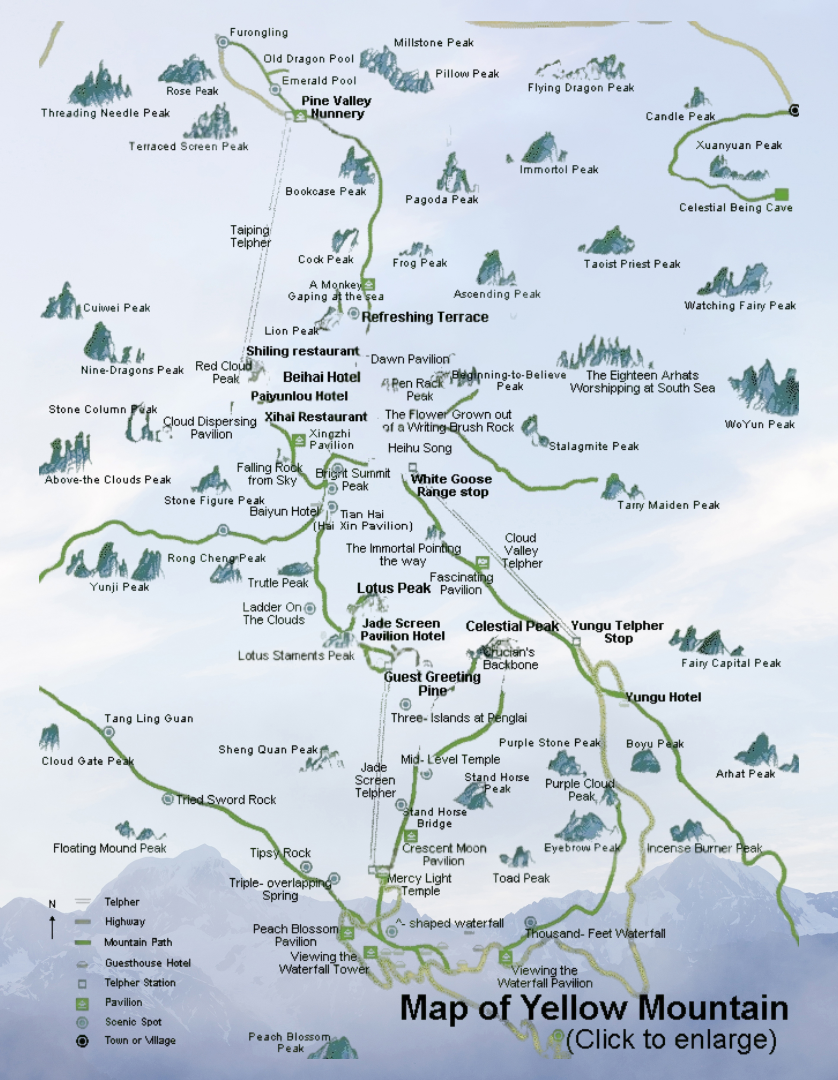
Huangshan Mountain boasts 72 peaks, and its three main peaks rise majestically more than 1,000 meters above sea level. It has more than 400 famous scenic attractions, 140 of which have been developed and opened to tourists. In 1990, Huangshan Mountain was included in both the world cultural and natural heritage lists.
How to Visit?
Huangshan Scenic Area has three entrance gates such as the south gate, west gate, and north gate. The vast majority of tourists will enter and exit through the south gate. The south gate also has two entrances and exits, front and back mountains, both located near Tangkou Town at the foot of the mountain.
Tangkou Town has also become a transit station for visiting Huangshan Mountain. Many tourists will arrive here in advance to stay overnight. You need to take Huangshan New National Line bus from Tangkou Town to the entrance gate of the scenic spot, and stop at the front mountain gate (Ciguang Pavilion), back mountain gate (Yungu Temple), and Mount Huangshan Hot Spring.
Huangshan Scenic Area is mainly divided into two uphill routes: the front mountain and the back mountain, both leading to Guangming Peak. On the other side of Guangming Peak, there is also a circular road - the West Sea Grand Canyon.
2 Days Huangshan Mountain Tour
The conventional way of visiting Huangshan Mountain is a two-day tour. The route is divided into front mountain up and back mountain down (front mountain - Xihai Grand Canyon - back mountain) and back mountain up and front mountain down (back mountain - Xihai Grand Canyon - front mountain). It is suitable to take the cableway up the front mountain and down the back mountain or walk down the mountain, which is both relaxing and beautiful. However, since the essence route of the West Grand Canyon is from Paiyun Pavilion to Tianhai, it is necessary to take a turn back.
1 Day Huangshan Mountain Tour
You can also visit Huangshan Mountain for only one day, but the schedule is very tight. It is recommended to go up and down the back mountain by round-trip cableway, and you needn't climb the main peak of the front mountain (Lianhua Peak/Tiandu Peak) or you won't go to the West Sea Grand Canyon.
What to see?
The front mountain refers to the climbing route from Ciguang Pavilion to Yuping Tower on the mountaintop (you can take the Yuping Cableway directly), as well as the Lianhua Peak and Tiandu Peak areas on the mountaintop. The scenery of the front mountain is grand to make tourists very suitable for taking a cableway to overlook. The peak Lianhua Peak and the other main peak Tiandu Peak are both located here (alternating between the two peaks), and classic attractions such as Welcoming Pine, Crucian Carp Back, Hundred Step Ladder, One Line Sky,etc. are also available.
Lotus Peak
Lutus Peak, also called Lianhua Peak, is the first peak of Mount Huangshan Mountain, with an altitude of 1864.8 meters. It is located in the north of Yuping Tower, opposite to Tiandu Peak. The Lotus Peak is steep and towering, resembling a blooming lotus flower from a distance, hence its name. Climbing the Lotus Peak allows you to have a panoramic view of the surrounding peaks, and when the weather conditions are suitable, you can also see a sea of clouds. The mountain path from Yuping Tower to Lianhua Peak is very steep, and the trail behind Lianhua Peak is relatively gentle.
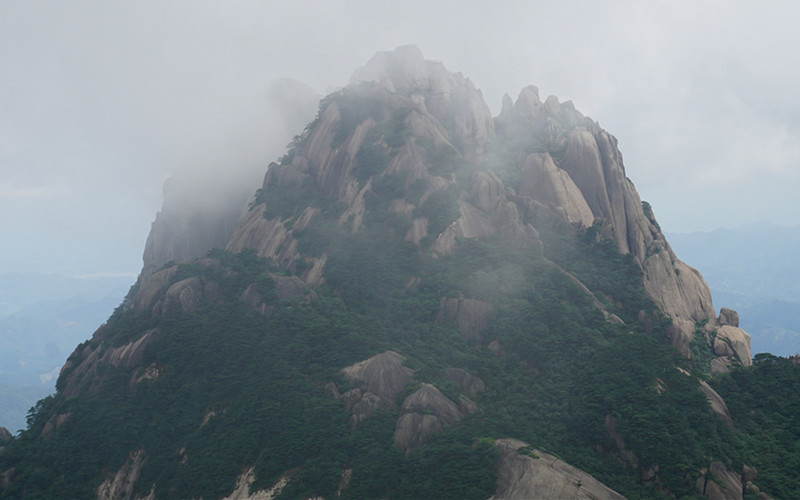
It is recommended to go up the mountain from Yuping Tower and down the mountain from the back. It is more dangerous to walk upside down. On Lianhua Peak, there are exotic pine trees such as Flying Dragon Pine and Inverted Hanging Pine, as well as scenic spots such as Moon Pond and Fragrant Sand Pond. There is a stone monument at an altitude of 1864.8 meters on the top of the mountain, and almost every tourist who climbs the summit will take a photo with the monument. In addition, like the peaks of other famous mountains, Lianhua Peak is adorned with various types of locks hanging on the iron ropes around the summit, most of which are heart to heart locks fastened by young couples or couples to show eternal unity.
Tiandu Peak
Tiandu Peak is located in the southeast of Mount Huangshan Scenic Area, facing Lianhua Peak in the west and Bowu Peak in the east. Together with Guangming Peak and Lianhua Peak, it is called the three main peaks of Mount Huangshan, with an altitude of 1810 meters. Tiandu Peak is famous for its precipitousness. Climbing the peak can overlook the magnificent panorama of Mount Huangshan Mountain.
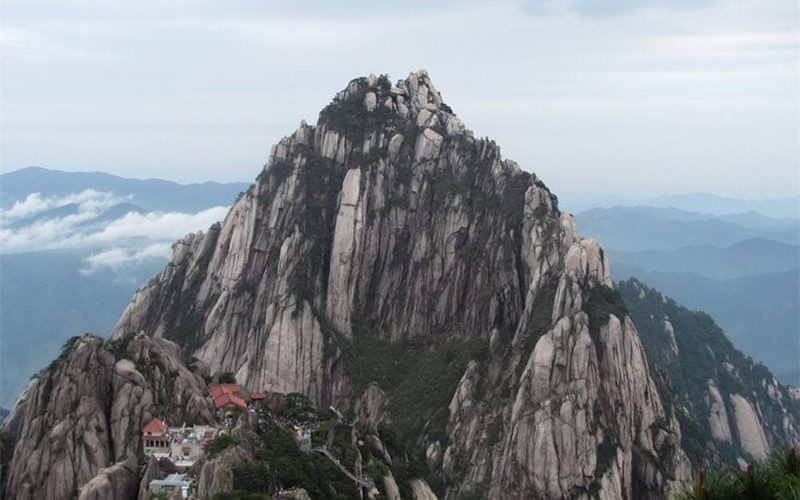
The entire mountain peak is divided into a south slope and a north slope. On the north slope, there is an old road. It is about 2 kilometers from the entrance of the old road to the summit of Tiandu, and it usually takes about an hour to walk up. The southern slope is a new road, and it is about 2.5 kilometers from the top of Tiandu to the Xindaokou. It usually takes about an hour and a half to walk.
Guest-Greeting Pine
The Guest-Greeting Pine is one of the landmarks of Mount Huangshan. It is located next to Yuping Building. If you go up the mountain from the front and climb to the Guest-Greeting Pine, it means you have reached Huangshan Mountain. The pine leans against the green lion stone and breaks through the stone, standing about 10 meters high. The tree is at least 800 years old, and one side of the branch extends out, resembling the host who extends his arm to welcome guests, with a graceful posture.
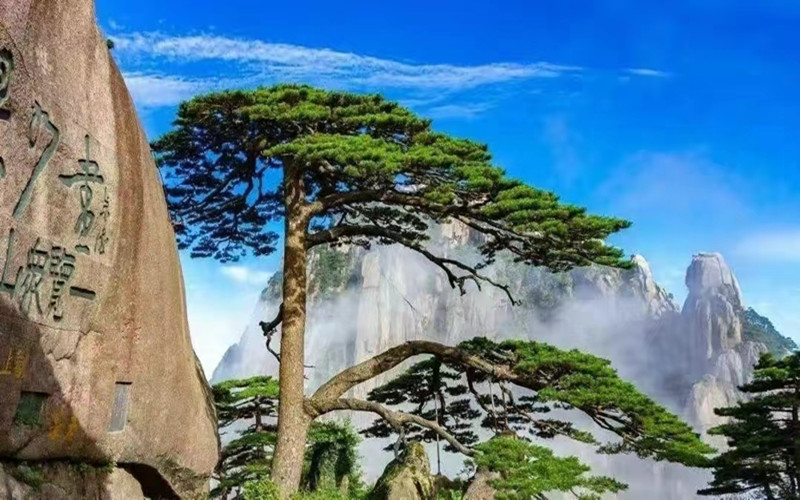
Near the pine, there are also landscapes such as Haohan Slope which is also known as Hero Hill. The so-called "Haohan Slope" refers to a staircase with over 370 steps and a slope of about 70 degrees. Through here, you can go to see the welcoming pine or go to Lianhua Peak. When descending the Hero Hill, looking at the cliff under one's feet is truly a place to exercise one's courage.
Guangming Summit
Guangming Summit, also called Guangping Peak, is the higher peak of Huangshan Mountain, with an altitude of 1860 meters. It is named for its high, open and long sunlight exposure. Climbing to the Guangming Peak for a stunning view is not only a great place to overlook the magnificent peaks around, but also a great place to see the sunrise, sunset, and sea of clouds.
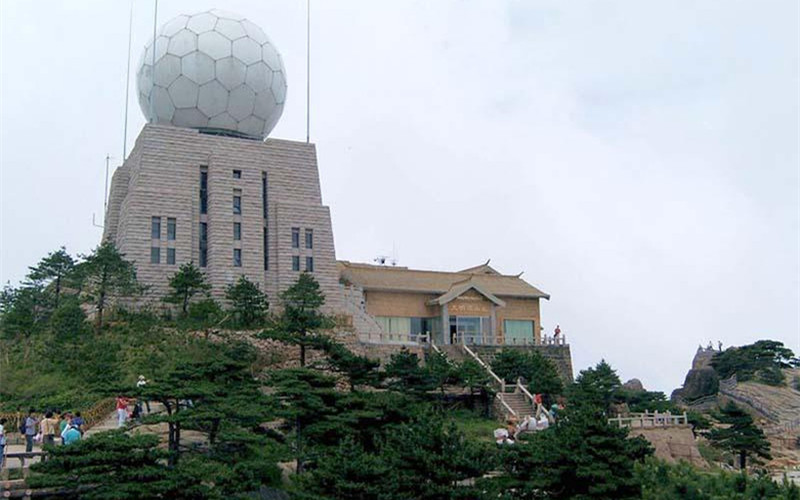
At Guangming Peak, you can enjoy the wonders of the East China Sea and the peaks of the West Sea, as well as the peaks of Tiandu, Lianhua, Yuping, and Aoyu. The so-called 36 peaks of Mount Huangshan are not Guangming Peak, because the ancients regarded Guangming Peak as the top of all peaks, so it was listed above the 36 peaks. Monk Pu Men in the Ming Dynasty once built the Dabei Temple on the top, and now there is a meteorological station with a higher altitude in East China - Mount Huangshan Meteorological Station.
Monkey watching the sea
Monkey watching the sea, a spot in Mount Huangshan, refers to a skillful stone sitting on a flat top peak in the north of Lion Peak, like a monkey squatting, watching the sea of clouds rise and fall. It is called "Monkey watching the sea".
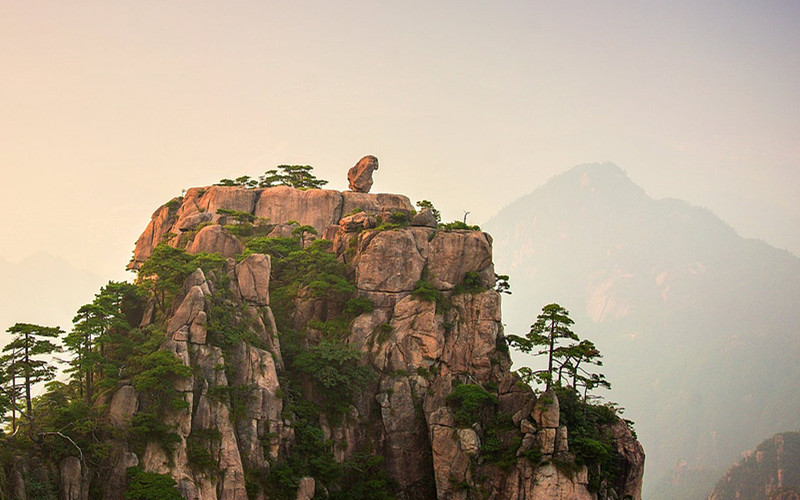
The back mountain refers to the hiking route from Yungu Temple to Bai'e Ridge (which can be directly reached by Yungu Cableway), as well as the mountaintop areas behind Bai'e Ridge such as Shixin Peak, Lion Peak, and Paiyun Pavilion. The scenery of the back mountain is mostly exquisite and suitable for walking along the way to enjoy. Feilai Stone and Monkey Viewing the Sea are all here.
The West Sea Grand Canyon is a newly opened scenic spot in recent years. It is deep in the valley, and the scenery is very magnificent. It is called the real essence of Mount Huangshan.
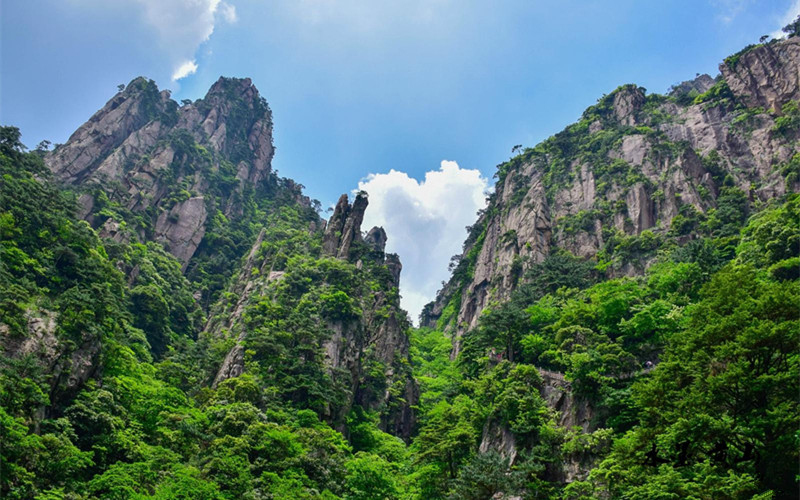
The West Sea Grand Canyon can be accessed from the Paiyun Pavilion on the mountaintop area of the back mountain, and after circling around the valley, it returns to the main peak Tianhai. It takes about 2 hours to walk from Paiyun Pavilion to the bottom of the valley, and then you can take a cable car to Tianhai.
Where to stay?
There are multiple accommodation locations on the mountaintop, mainly concentrated in several areas such as Guangming Peak, Tianhai Spot, Paiyun Pavilion, White Goose Ridge, and Beihai Spot. Guangming Peak-Tianhai Spot is a great place to watch the sunrise, and it is also suitable for luggage when you visit in the West Sea Grand Canyon. White Goose Ridge is the upper stop of the Cloud Valley Cableway in the back mountain. It is usually suitable to stay here in the afternoon when you enter the scenic area from the back mountain.
When to visit ?
Winter in Mount Huangshan (late October - February of the next year) is called the most beautiful season in Mount Huangshan by tourists. Whether covered by snow or rime, Mount Huangshan is enchanting and beautiful at this time. However, in winter, Tiandu Peak and Baiyun Creek will be closed for maintenance, which will cause some inconvenience to tourists who like photography and climbing;
Try to avoid golden holidays (too many people make it difficult to climb mountains or enjoy the scenery) and rainy season tourism (around mid June to early July during the rainy season), as the travel experience will be affected and discounted.
The cloud sea in Mount Huangshan Mountain has the highest probability in winter and spring, and the probability in summer and autumn is relatively low.
The scenery of Mount Huangshan varies throughout the year, especially in summer and autumn. At this time, Mount Huangshan is the peak tourist season, with the most suitable temperature and lush mountains. Although winter is also beautiful, it is not recommended to climb Mount Huangshan Mountain in winter because the temperature at the top of the mountain is too low and the mountain roads are icy and slippery, which can easily cause danger.
Travel Tips
Address: No. 1, Tangquan Road, Tangkou Town, Mount Huangshan District, Mount Huangshan City
Phone: 055955611110559-2590999
Official website: http://hsgwh.huangshan.gov.cn/
Opening hours: 06:00-18:00
Entrance Fee: Entrance Ticket CNY 195 ; Taiping Cablecar CNY 90/ p.p (one way); Yuping Cablecar CNY90/P.P(one way), Yungu Cablecar CNY 80/p.p ( One way)
